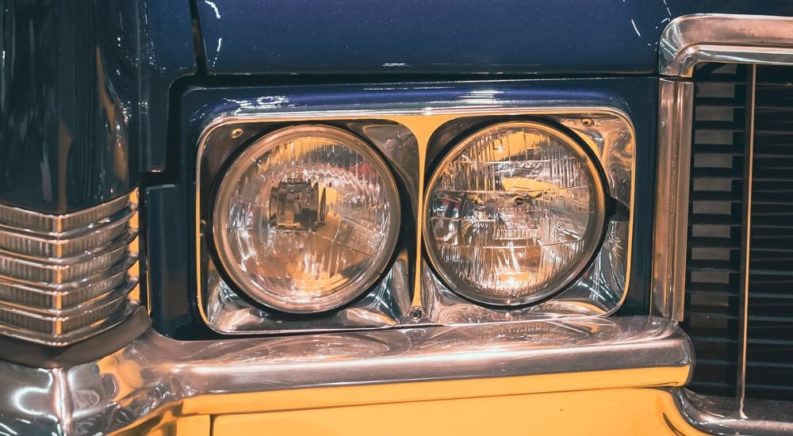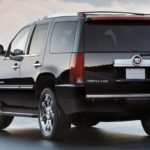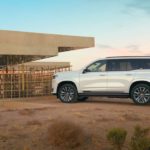I’ll never forget my dad’s first Cadillac. It was a ’69 Sedan DeVille in Shalimar Gold. But what made it so memorable was the first road trip we made in that Cadillac. It was August 15, 1969, and we were heading to my uncle’s summer home in the Catskills. All that stood between us and a fun weekend by the lake was about 120 miles of highway and every single Hippie in the northeastern United States. My dad decided to break in his new Cadillac the same weekend as Woodstock. By the end of the weekend, his brand-new Sedan DeVille would qualify as a used Cadillac, and we’d also have a story to hand down for generations of my family. It was all about getting stuck on the New York State Thruway in a ’69 Cadillac Sedan DeVille heading in the same direction as Max Yasgur’s farm.
An Amazing Cadillac Legacy
Before becoming my family’s unwitting contribution to the caravans of the Woodstock Nation, Cadillac had built its reputation as the finest luxury vehicle built in America. It all started when Henry Leland convinced a group of former Ford board members that he could build the ultimate car. It was 1902, and in seven short years, Leland had turned Cadillac into one of the best automobiles on the market. Automotive legend William Durant of General Motors took note and made Leland an offer he couldn’t refuse. From that day on, Cadillac became the luxury standard of the world’s largest auto company, General Motors.
Leland chose the name Cadillac because it was the name of the French explorer Antoine de la Mothe Cadillac, who founded the settlement that would become Detroit. While the explorer Cadillac may have created Detroit, the brand truly put Detroit on the map. Featuring powerful V8, V12, and V16 gas engines, early Cadillac models like the LaSalle set a standard for automotive excellence that other brands could only aspire to.
The Sedan Went Cruising
Post-war, Cadillac really hits its stride. One of the most iconic models was the Sedan DeVille. The DeVille started as a top trim level on another model, the 1949 Cadillac Series 62. However, after a decade of increasing sales, the folks at Cadillac decided to give the DeVille name to a new series of sedans and coupes that would be among the best-loved in the history of the Cadillac brand.
The first generation of the Cadillac DeVille was also the briefest in the model’s history. Just two short years, but what an incredible two years they were. The first DeVille models appeared in 1959 and featured the most extreme tailfins in the history of Cadillac. Dual bullet taillights offset the tailfins and were eventually toned down a bit for 1960, but the overall vehicle was the same. Drivers had two options: a two-door Coupe DeVille or a four-door Sedan DeVille. However, other than the folding front seats on the Coupe DeVille, there were no real differences between the two models. The car sported a powerful 6.4-liter V8 engine with the added luxury of standard 4-speed Hydra-Matic automatic transmission. If you were paying for the privilege of owning a Cadillac, you shouldn’t have to hassle with a stick and a clutch.
In keeping with the New Frontier of the Kennedy Administration, the 1961 Cadillac DeVille was given a more quietly classy and sporty look. It offered lower tailfins, improved aerodynamics, and forward-slanted front pillars. The second generation DeVille looked like it was pressing into the future, even when the car was in park. The 6.4-liter V8 was carried over from the first generation, with an optional 7.0-liter V8 added for folks who wanted to push the speed limits. The Coupe DeVille even had a ragtop option for those who were California Dreaming. The Cadillac DeVille became the car for the jet-setting, go-go generation.
Going Boldy Where No Cadillac Has Been Before
The third generation Cadillac DeVille premiered in 1965, one year after I was born. The tailfins were gone, left to the early days of sock hops and the twist. Also gone was the X-Frame, replaced with a more modern perimeter frame. The new DeVille featured a beveled front end that gave this model a more aggressive look. Cadillac also added more comfort features, including luggage lamps in the trunk and standard safety belts. The standard 7.0-liter V8 engine with 340 hp was eventually replaced in 1968 with an even more powerful 7.7-liter V8 engine. Cadillac also standardized its efficient 3-speed turbo Hydra-Matic automatic transmission.
This was the model my dad unwittingly drove to Woodstock that weekend back in 1969. We were in our luxury, brand-new Sedan DeVille surrounded by the flotsam and jetsam of Hippiedom in their painted VW Microbuses and late model Chevys and Fords. It was a traffic jam for the ages. You see, Woodstock wasn’t actually in Woodstock. If it were, we’d have been fine. However, the town fathers blocked the music festival, leaving it to relocate to Max Yasgur’s farm in Bethel, just ten miles from Monticello, where my uncle had his house by the lake. Arlo Guthrie famously quipped at Woodstock, “The New York State Thruway’s closed man! Can you dig it?” I can attest that Arlo spoke words of truth.
Going Town to Town Over the Years in the DeVille
When the time came, my dad traded in that ’69 Sedan DeVille for a ’73 model in chocolate brown. This came with a Cabriolet roof option, a soft landau-style treatment in a beige color, giving our fourth-generation Cadillac a cool, two-tone look. It was roomier than the previous model, with a larger 8.2-liter V8 engine. The good news is that it had an exceptional pickup, but the bad news is that my dad got this just in time for the first Oil Embargo. Those leather seats were really comfortable while we waited in line at the gas station to fill up our DeVille’s gas tank.
As a result of the gas crisis, the fifth-generation Cadillac DeVille was smaller. The front end was shortened with a boxier grille and headlights. The only thing that was larger was the trunk. Cadillac also stopped offering the Coupe DeVille with a convertible due to declining sales. Introduced in 1977, this model also saw a decline in engine size during its generation. The DeVille went from a 7.0-liter V8 in 1977 to a choice 4.1-liter V8 and a 4.1-liter V6 by the end of its run. In an effort to improve fuel economy, Cadillac introduced a 5.7-liter Diesel V8 in 1980, an option that would continue until 1985 and the sixth generation model.
While the Sedan DeVille remained a big seller for Cadillac through the sixth generation, they decided in 1993 to discontinue the Coupe DeVille. Folks wanted a full-size car with four doors. The sixth generation was also smaller than the fifth generation model, with a boxier look. This was remedied with the seventh generation, which had a more sloped styling and sportier appearance. It also was built alongside the Cadillac Seville to help capture economies of scope. The seventh generation was also the first to feature Cadillac’s efficient Northstar V8 engine.
The End of the Cadillac DeVille and the Woodstock Nation
Good things don’t always last forever, and this is true with music and cars. The Woodstock Nation only lasted another year or two, following the Oscar-winning Woodstock documentary released in 1970. Unfortunately, the legacy of the Cadillac DeVille was longer. The last Sedan DeVille rolled off the assembly line in 2005. This was part of the eighth generation. Despite innovations like Continuously Variable Road-Sensing Suspension and Night Vision, sales of the Sedan DeVille had declined to the point where Cadillac had to focus on newer models. Folks weren’t interested in driving a full-size sedan with a V8 engine. They chose models like the full-size Cadillac Escalade SUV as the luxury vehicle of choice.
There is always the chance that things will come back. Woodstock was immortalized in song by Joni Mitchell. Meanwhile, used Cadillac DeVille models continue to be sought after by car collectors worldwide. There is always the chance that Cadillac will bring back the DeVille name for a new model. For now, Woodstock and my dad’s ’69 Sedan DeVille will remain entwined in memory: a historic concert and a legacy of luxury automotive history together forever.




